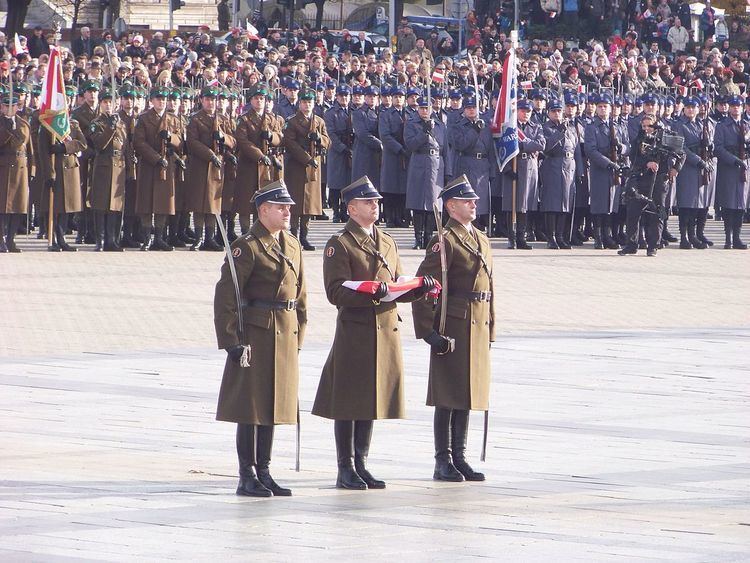Frequency annual | Date 11 November | |
 | ||
Significance To commemorate the recovery of a sovereign state by the Poles in 1918 Next time 11 November 2017 (2017-11-11) | ||
National Independence Day (Polish: Narodowe Święto Niepodległości) is a national day in Poland celebrated on 11 November to commemorate the anniversary of the restoration of Poland's sovereignty as the Second Polish Republic in 1918, after 123 years of partition by the Russian Empire, the Kingdom of Prussia and the Habsburg Empire. It is a non-working day in Poland.
Contents
Significance of the date
The restoration of Poland's independence was gradual. The 11 November date chosen is the one on which Józef Piłsudski assumed control of Poland. The holiday was constituted in 1937 and was celebrated only twice before World War II. After the war, the communist authorities of the People's Republic removed Independence Day from the calendar, though reclamation of independence continued to be celebrated informally on 11 November. The holiday was officially replaced by the National Day of Poland's Revival as Poland's National Day, celebrated on the 22 July anniversary of the communist PKWN Manifesto under Josef Stalin. As Poland emerged from Soviet-influenced communism in 1989, the original holiday—on its original 11 November date—was restored.
The date corresponds to the date of other countries' Remembrance Day, Armistice Day, or Veterans Day. All of these holidays and Polish Independence Day are indirectly related because they all emerged from the circumstances at the end of World War I. In other countries, holidays were established in the spirit of grief and horror at the enormous human cost of the war, and they mark the sacrifices of those who fought. For Poland, however, the tragedy of the war was tempered by what had been accomplished at its end: the restoration of a sovereign Polish state that had been lost entirely in the partitions of Poland, after 123 years of struggle. The Polish holiday is therefore simultaneously a celebration of the reemergence of a Polish state and a commemoration of those who fought for it.
Historical meaning
Crucial to restoring independence was the defeat in the war of all three of the occupying powers. Russia was plunged into the confusion of revolution and civil war, Austria-Hungary disintegrated and went into decline, and the German Reich bowed to pressure from the forces of the Entente. For Poles, this was a unique opportunity to reclaim their independence. Following the defeat of the occupying forces, the Poles seized military and civil power, building the foundations of their future state. On October 28, 1918 the Polish Liquidation Commission was formed in Kraków. The Commission seized power from the Austrians in Galicia and Cieszyn Silesia. A few days later they succeeded in disarming the Austrian forces using members of the secret Polish Military Organisation as well as legionnaires and young people. On the nights of 6 and 7 November the Provisional Government of the People's Republic of Poland was formed in Lublin under the supervision of Ignacy Daszyński. The government was made up of representatives from the Polish Socialist Party (PPS), the Polish Social Democratic Party (PPSD) and the Polish People's Party "Wyzwolenie" (Liberation). At the same time the Government troops disarmed the occupying forces in Lubelszczyzna and Kielecczyzna. It was at this point that the country's future head of state, Józef Piłsudski, returned to Poland after incarceration by the Germans. His 10 November arrival in Warsaw was enthusiastically met by the population of the capital and saw the mass disarmament of the occupying forces across the whole of Poland. Piłsudski assumed authority on 11 November, forming a new centralized government and soon calling parliamentary elections.
Notable dates in history
Most recent controversies
Starting in 2008 on 11 November in Warsaw selected nationalist organizations participated in a "March of Independence" launched by the far-right National Radical Camp and All-Polish Youth leading to notable violent incidents and arrests. During the 2012 clashes between extremists and the police, 176 rioters were detained and 22 police officers wounded. In 2013 a group of 72 far-right hooligans were detained and 12 police officers taken to hospital. Damages to private and public property by the masked youth was estimated at 120,000 zł. Significant act of vandalism included the burning of the LGBT "Tęcza" Rainbow Arch at a Warsaw square, others took place near the Russian embassy. The unofficial march was declared illegal by the authorities and the city. As of April 2014 administrative courts continue to analyze evidence.
However, the desire for street celebrations has already been expressed by the public. In 2011 over 20,000 people took place in a daytime march in different cities, preceding the nighttime clashes in Warsaw. In response, the President of Poland Bronisław Komorowski proposed in 2011 that he will lead the new official Independence March in 2012. His offer was backed by the ruling PO and PSL coalition, but opposed by the nationalists.
As of 2012 there is a popular and all-inclusive march taking place in Warsaw led by the President under the name "Razem dla Niepodległej" ("Together for the Independent"). It is considered a continuation of the official ceremonies of the anniversary, and accompanied by patriotic displays and songs. The number of participants in the 2012 Presidential march was estimated at 10,000.
Meanwhile, the violent incidents were heavily covered in the Polish media, with commentators criticizing the lack of leadership on the part of the government in the face of the extremity of the far-right rhetoric. The media coverage is seen as selective and unduly focused on riots instead of the Presidential march which is in no way connected with them.
